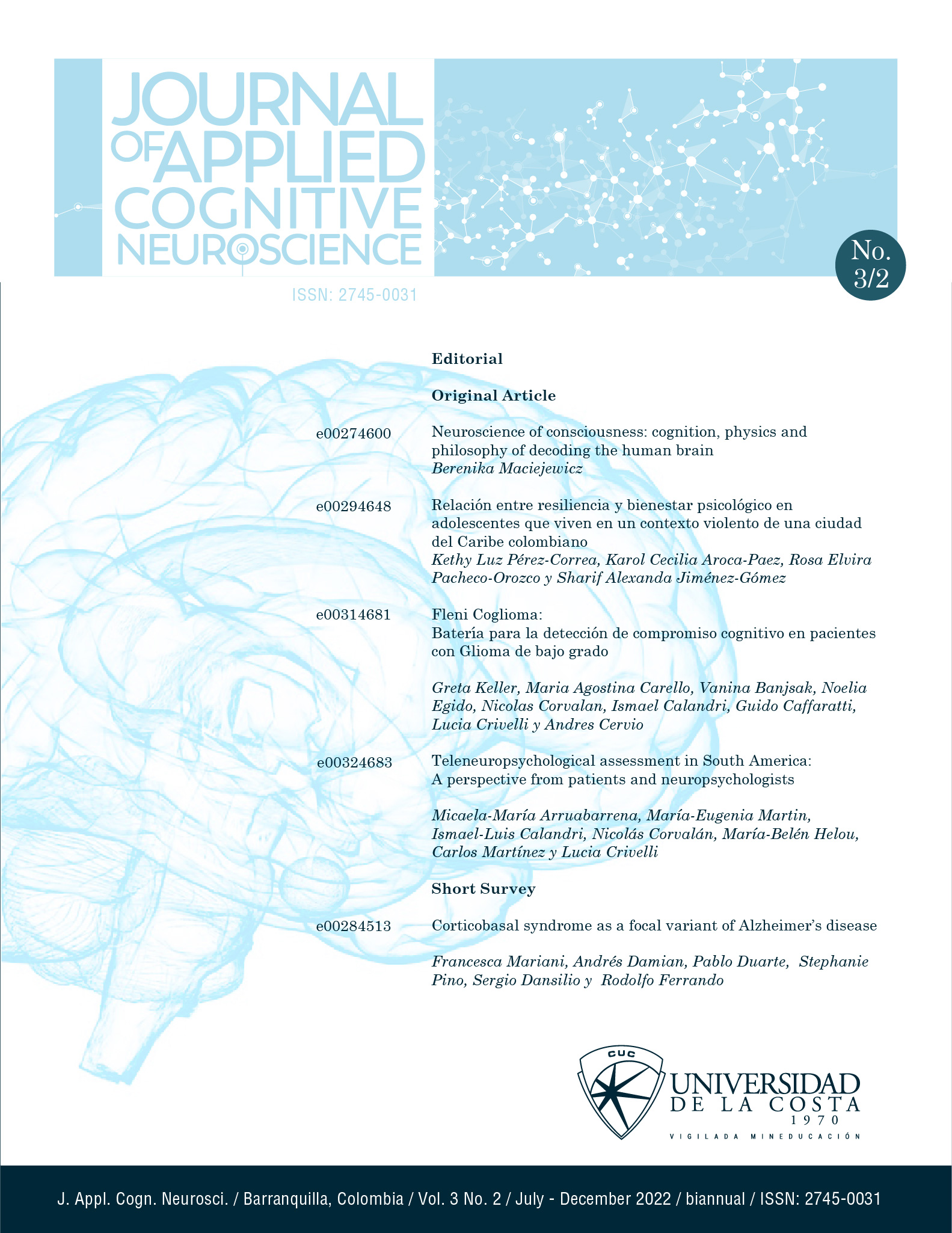Teleneuropsychological assessment in South America: A perspective from patients and neuropsychologists
DOI:
https://doi.org/10.17981/JACN.3.2.2022.05Keywords:
Teleneuropsychology, COVID-19, Cognitive assessment, Telehealth, TelemedicineAbstract
Teleneuropsychology (teleNP) in Argentina was promoted by the COVID-19 pandemic. This investigation aimed to evaluate patients’ and neuropsychologists’ satisfaction with teleNP and to identify the advantages and disadvantages of its use. 41 patients with mild cognitive impairment and 35 neuropsychologists from Argentina were surveyed. Both groups were sent a questionnaire by e-mail to evaluate their satisfaction and preferences regarding teleNP. Patients were sent the survey after being cognitively evaluated by teleNP. Outcomes reflected a 91% degree of satisfaction with teleNP, with no differences between patients and specialists (p = 0.112). Regarding patients, 50% had no predilection regarding evaluation modality, and 35.7% preferred teleNP. The main benefits identified were accessibility to remote areas (72.4%), and comfort of performing the assessment at home (57.14%). Moreover, 74.3% of practitioners reported that the principal difficulty was the patient’s lack of familiarity with the technology, and 60% a deficiency in environmental control. TeleNP cognitive evaluation has a high degree of acceptability for practitioners and patients. The main obstacles identified are network connection problems and the lack of familiarity with technology. The principal advantages come from accessing isolated areas. This suggests that this practice will remain relevant beyond the pandemic context.
Downloads
References
Bilder, R. M.; Postal, K. S.; Barisa, M.; Aase, D. M.; Cullum, C. M.; Gillaspy, S. R.; Harder, L.; Kanter, G.; Lanca, M.; Lechuga, D. M.; Morgan, J. M.; Most, R.; Puente, A. E.; Salinas, C. M. & Woodhouse, J. (2020). Inter Organizational Practice Committee Recommendations/Guidance for TeleNeuropsychology in Response to the COVID-19 Pandemic. Archives of clinical neuropsychology: the official journal of the National Academy of Neuropsychologists, 35(6), 647–659.
https://doi.org/10.1093/arclin/acaa046
Calandri, I. L.; Hawkes, M. A.; Marrodan, M.; Ameriso, S. F.; Correale, J. & Allegri, R. F. (2021). Changes in the Care of Neurological Diseases During the First Wave of the COVID-19 Pandemic: A Single Private Center Study in Argentina. Frontiers in Neurology, 12, 1–8.
https://doi.org/10.3389/fneur.2021.613838
Chappell, N. L. & Zimmer, Z. (1999). Receptivity to new technology among older adults. Disability and Rehabilitation, 21(5-6), 222–230.
https://doi.org/10.1080/096382899297648
CNSS. (2010). National information assurance (IA) glossary. Retrieved from https://www.cnss.gov/cnss/
Crivelli, L.; Quiroz, Y. T.; Calandri, I. L.; Martin, M. E.; Velilla, L. M.; Cusicanqui, M. I.; Coto, F.; Llibre-Rodríguez, J. J.; Armele, M.; Román, F.; Barceló, E.; Dechent, C.; Agostina, M.; Olavarría, L.; Yassuda, M. S.; Custodio, N.; Dansilio, S.; Sosa, A. L.; Acosta, D. M.; Brucki, S. M. D.; Caramelli, P.; Slachevsky, A.; Nitrini, R.; Carrillo, M. C. & Allegri, R. F. (2021). Working Group Recommendations for the Practice of Teleneuropsychology in Latin America. Archives of Clinical Neuropsychology, 37(3), 553–567
https://doi.org/10.1093/arclin/acab080
Cullum, M. C.; Hynan, L. S; Grosch, M.; Parikh, M. & Weiner, M. F. (2014). Teleneuropsychology: Evidence for Video Teleconference-Based Neuropsychological Assessment. Journal of the International Neuropsychological Society, 20(10), 1028–1033.
http://dx.doi.org/10.1017/S1355617714000873
Elwood, D. L. & Griffin, R. (1972). Individual intelligence testing without the examiner. Journal of Consulting and Clinical Psychology, 38(1), 9–14.
https://doi.org/10.1037/h0032416
Fox-Fuller, J. T.; Rizer, S.; Andersen, S. L. & Sunderaraman, P. (2022). Survey Findings About the Experiences, Challenges, and Practical Advice/Solutions Regarding Teleneuropsychological Assessment in Adults. Archives of clinical neuropsychology: the official journal of the National Academy of Neuropsychologists, 37(2), 274–291.
https://doi.org/10.1093/arclin/acab076
Galusha-Glasscock, J. M.; Horton, D. K.; Weiner, M. F. & Cullum, C. M. (2016). Video Teleconference Administration of the Repeatable Battery for the Assessment of Neuropsychological Status. Archives of clinical neuropsychology: the official journal of the National Academy of Neuropsychologists, 31(1), 8–11.
https://doi.org/10.1093/arclin/acv058
Harrell, K. M.; Wilkins, S. S.; Connor, M. K. & Chodosh, J. (2014). Telemedicine and the Evaluation of Cognitive Impairment: The Additive Value of Neuropsychological Assessment. Journal of the American Medical Directors Association, 15(8), 600–606.
https://doi.org/10.1016/j.jamda.2014.04.015
Morris, A.; Goodman-Deane, J. & Brading, H. (2007). Internet use and non-use: Views of older users. Universal Access in the Information Society, 6, 43–57.
https://doi.org/10.1007/s10209-006-0057-5
https://doi.org/10.1017%2FS1355617714000873
Rentz, D. M.; Dekhtyar, M.; Sherman, J.; Burnham, S.; Blacker, D.; Aghjayan, S. L.; Papp, K. V.; Amariglio, R. E.; Schembri, A.; Chenhall, T.; Maruff, P.; Aisen, P.; Hyman, B. T. & Sperling, R. A. (2016). The Feasibility of At-Home iPad Cognitive Testing For Use in Clinical Trials. The journal of prevention of Alzheimer´s disease, 3(1), 8–12.
https://doi.org/10.14283/jpad.2015.78
Soto-Pérez, F.; Franco, M. y Jiménez, F. (2010). Tecnologías y neuropsicología: Hacia una ciber-neuropsicología. Cuadernos de Neuropsicología, 4(2), 112–130.
https://www.cnps.cl/index.php/cnps/article/view/106
Stricker, N. H.; Lundt, E. S.; Alden, E. C.; Albertson, S. M.; Machulda, M. M.; Kremers, W. K.; Knopman, D. S.; Petersen, R. C. & Mielke, M. M. (2020). Longitudinal Comparison of in clinic and at Home Administration of the Cogstate Brief Battery and Demonstrated Practice Effects in the Mayo Clinic Study of Aging. The journal of prevention of Alzheimer´s disease, 7(1), 21–28.
https://doi.org/10.14283/jpad.2019.35
Wadsworth, H. E.; Dhima, K.; Womack, K. B.; Hart, J.; Weiner, M. F.; Hynan, L. S. & Cullum, C. M. (2018). Validity of TeleNeuropsychological Assessment in Older Patients with Cognitive Disorders. Archives of Clinical Neuropsychology. 33(8), 1040–1045.
Published
How to Cite
Issue
Section
License
Copyright (c) 2022 Journal of Applied Cognitive Neuroscience

This work is licensed under a Creative Commons Attribution-NonCommercial-NoDerivatives 4.0 International License.
You are free to:
- Share — copy and redistribute the material in any medium or format.
- The licensor cannot revoke these freedoms as long as you follow the license terms.
Under the following terms:
- Attribution — You must give appropriate credit, provide a link to the license, and indicate if changes were made. You may do so in any reasonable manner, but not in any way that suggests the licensor endorses you or your use.
- NonCommercial — You may not use the material for commercial purposes.
- NoDerivatives — If you remix, transform, or build upon the material, you may not distribute the modified material.
- No additional restrictions — You may not apply legal terms or technological measures that legally restrict others from doing anything the license permits.


 English
English
 Español (España)
Español (España)










